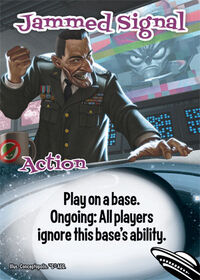
- This page is about general strategies that apply to most/all factions. For strategies specific to each faction, see that particular faction's page.
The standard way to win is to break bases on your turn with you in first place. This may sound obvious and simplistic, but it is easy to lose sight of, especially when your factions are capable of seemingly-powerful plays such as destroying enemy minions. If your factions can directly earn victory points (Aliens, Ghosts, Minions of Cthulhu), do that too. But again, the most important thing to do is to score bases on your turn with you in first place.
Your strategy needs to take into account the factions you're playing, the factions your opponents are playing, and the bases currently in play. While this may also seem obvious and simplistic, each of these three things should play important and subtle roles in your strategy. For example, you should know whether or not it's possible for you to ever play multiple actions in one turn, and how to do it. You should know whether or not your opponents can destroy your actions, and how many cards do they have with that ability. There are also some bases which have a significant effect on the game, such as Mushroom Kingdom, that you should stay aware of when deciding what to do on your turn.
Choosing a Base to Play On
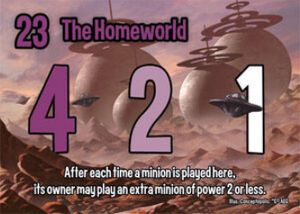
First and most importantly, you should be aware of the bases with really significant abilities. These include Mushroom Kingdom, Cave of Shinies, The Homeworld, The Central Brain, Secret Grove, and others. Many of these base's abilities lend them to being easily broken, which means if you're not playing there right away, you may get left out when the base breaks.
If another player has started playing on a base, you should probably play there too to prepare for a Big Drop (see below) and to prevent an Inevitable Landslide. However, if all the bases are empty, read on.
Take into account any base with an ability that matters before it's scored, such as Inventor's Salon vs The Dread Gazebo. Cross check the base abilities against the factions that you and your opponents are playing. Bases are more attractive if they favor your strategy and are hostile to your opponents strategy.
Next look at the VP rewards of the bases in play. Bases are more attractive that have a 2-point delta between first and second place, such as 4 2 1 as opposed to 3 2 1. Bases with a higher first-place prize are more attractive, with a 5+ VP reward being especially prized. Since a game is to only 15 points, a 5-point prize is 1/3 of the game.
Next look at the breakpoints of the bases in play. Bases with lower breakpoints are more attractive because they are easier to break, and will probably give you more VPs per card you play there. Pay special attention to Tar Pits which has a peculiarly high VP-to-breakpoint ratio.
Finally, consider the abilities of the bases that reward the winner after the base breaks. This is usually not very important, and you shouldn't rely on it, since you are not guaranteed to get it.
Breaking a Base
There are several general approaches to breaking a base.
The Big Drop
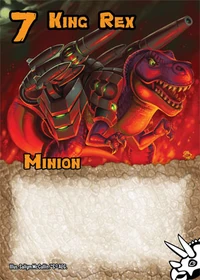
This is the easiest way to break a base. It involves playing a huge amount of power in one turn to break a base suddenly, e.g. from maybe 9 existing power to playing 12 power on your turn to break the base at 21 power. High-powered minions are valuable for this (King Rex, General Ivan, etc.) as well as actions that either boost power (Augmentation, Aggromotive, Dunwich Horror, etc.), or allow you to play extra minions (Commission, Summon, etc.).
When preparing for the Big Drop, be careful not to put too much power on a base before you're ready, or else someone else will beat you to it. Since the Big Drop is the easiest strategy, your opponents will most likely be going for it as well. This means playing minions on a new base tends to be a game of hesitation, each player slowly adding small amounts of power, hoping they have a bigger drop planned than their opponents suspect. A rookie mistake is to play too much power on a base without breaking it, such that your opponent can play a relatively low amount of power (say 5 power) to both break the base and win first place.
The Inevitable Landslide
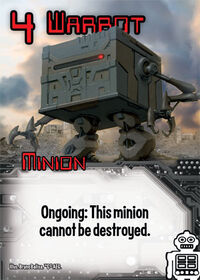
An alternative to the Big Drop is gaining such a huge lead on a base, your opponents feel powerless to surpass you. In a two player game, this can often lead to the base stagnating as it is, both players waiting for the other to spend a minion to finally break the base and bring about the inevitable conclusion. If one player or the other has particularly disruptive abilities (destroying, returning to hands, etc.), their opponent will be more motivated to be the one to spend the minion to ensure the safety of their position on the base. In a three or four player game, the base will break quickly as players clamber for second place.
The Bait and Switch
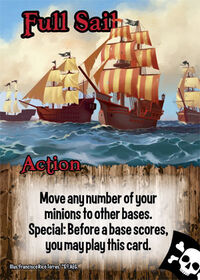
This strategy is a bit tricky to set up. It involves building up a presence on bases you don't intend to break, and then suddenly moving the minions on your turn to break a base your opponents did not suspect, preferably alone. Valuable abilities are Talent moves (Captain Ahab, Zeppelin, Snow White, etc.) and multi-move actions (Dinghy, Sea Dogs, Invisible Bicycle, etc.). This is really a variation on the Big Drop above, so any abilities that help there will help here as well.
This strategy is vulnerable to opponents destroying your minions before you can move them to the goal, which makes defensive abilities helpful (Incorporeal, Wildlife Preserve, Smoke Bomb, etc.).
Slow and Discouraging
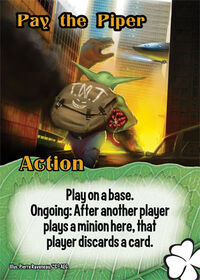
This is the least effective way to break bases, but can help buy you time to farm VPs from special abilities. The idea is that you want to prevent a base from breaking either indefinitely or until you have time to play enough power to win first place. Helpful abilities reduce minion power (Sleep Spores, Enchantment, Hissy Fit, etc.), clearing off minions from a base (Crop Circles, Nukebot, Complete the Ritual, etc.), or discouraging opponents from continuing to play on a base where they are already somewhat invested (Leprechaun, Pay the Piper, Furthering the Cause, etc.). Keep in mind that if you need to contribute 7 minions to break the base, you're probably working too hard for too little. Typically, you want your opponents to help you break bases so that you don't need to spend so many cards for only 3-5 VP. If you discourage your opponents from playing on one base, they will probably abandon their minions there and start focusing on a different base instead, so watch out for other bases breaking without you on them.
Using Abilities Effectively
While a minion's ability may seem significant, don't forget that the minion's power is probably more significant, because breaking bases is the best way to earn VPs.
Destroying Enemy Minions
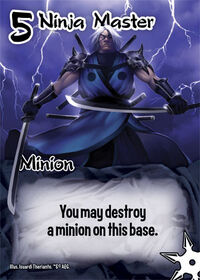
Destroying enemy minions seems like a very powerful ability, but never lose sight of the real goal of the game: to earn VPs (I'm lookin' at you, Bear Cavalry). That said, there are times when it is beneficial to destroy enemy minions and also times when it is counterproductive to do so.
Destroying enemy minions is very effective at preventing the Bait and Switch above, so don't underestimate how valuable it can be to destroy a lone minion on a base that seems to be doing no harm. You should know if your opponents are capable of the Bait and Switch (Steampunks, Pirates, etc.) and be particularly aggressive toward them if they seem to be building up for that strategy. Also, if you're playing against a faction that can't play extra minions very well (Dinosaurs, Super Spies, etc.), destroying their lonely minions can be significant setbacks in their plan to build up power.
It's not always productive to destroy minions in a Big Drop situation. When breaking a base, it's actually helpful for your opponents to contribute some of the power as long as you still get the first place prize. This can make mandatory destroying abilities such as Laseratops and Microbot Guard counterproductive to your strategy.
Destroying enemy minions with powerful ongoing abilities is often a good idea, but not always. If someone leaves a Microbot Fixer, Archmage, Water Lily, etc. unguarded, those minions are often good candidates for being destroyed, but destroying a minion is only one way to get rid of their ongoing abilities. Don't forget that breaking a base will also remove them from play, so allowing the minion to help you break a base with a Big Drop can be just as effective as destroying it, if not more so. (Of course, that doesn't work against First Mates, which makes them particularly high priority targets for destruction.)
Destroying enemy minions can be a good way to affect a two-player Inevitable Landslide situation. If you have the advantage and your opponent thinks they are safe with a single power 3 minion on your base, try to destroy them and break the base on the same turn. If you can't do both at once, it's probably not worth destroying the minion, as they will surely restore their position with another minion on their turn. If your opponent has the advantage, it's valuable to chip away at their lead by destroying their minions there. This makes them uneasy about their lead, forcing them to spend cards to break the base themselves. It can even reduce their power so much as to allow you to take the base with your own Big Drop.
Destroying Your Own Minions
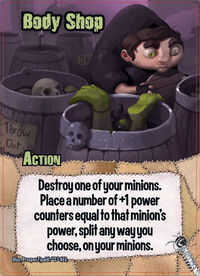
While obviously not recommended in general, there are some abilities that make it beneficial to target your own own minions for destruction rather than your opponents' minions. The most obvious example is Cave of Shinies, but remember that breaking the base will still probably give you more VPs than tediously farming 1 VP per turn.
If you must destroy your own minions because of the requirement on card text (Sacrifice, Whiskers, etc.), the best minion to destroy is an opponent's minion that you have gained control over temporarily (Cat's Paw, Muffin, etc.). You want these minions to die, because otherwise control of them will be handed back to opponents. Note that even Make Contact is temporary if your opponents can destroy actions played on minions.
If you cannot control minions, your next priority should be to target an indestructible minion (Warbot, Überserum, etc.). Note that Incorporeal and similar abilities will not protect you from suicide. Also note that sometimes card text requires the minion to actually die, such as Elder Thing under some interpretations.
Next, try to choose a minion that has some benefit when killed, such as Igor or Gremlin. Then try to choose a minion that doesn't stay dead for long, such as Tenacious Z or Jumper.
If all else fails, you might want to reconsider the suicide. For the United States, call the National Suicide Prevention Lifeline at 1-800-273-8255. But if you really are intent on sacrificing one of your minions, I suppose you should choose a weak one.
Moving Your Minions
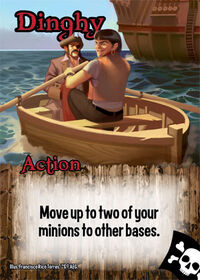
Moving around is not necessary for the Big Drop or Inevitable Landslide strategies, but it is the basis for the Bait and Switch strategy, and can be used to work around someone using the Slow and Discouraging strategy on you.
Moving is useful for getting your minions onto bases that discourage you from playing there (Tsar's Palace, Haunted House, etc.). It is also useful to escape bases that discourage you from having minions there (Sleep Spores, Furthering the Cause, etc.).
Moving Enemy Minions
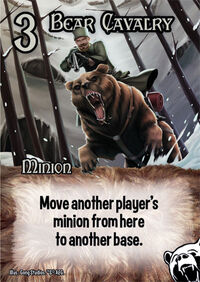
Moving enemy minions is a somewhat rare ability that can be advantageous when used appropriately. You can remove your opponent's presence from your Inevitable Landslide setup to break the base alone, or move some of your opponents minions to reinforce his or her second-place position, thereby wasting the minions.
There are also some special case uses for moving opponents minions:
- Removing a Leprechaun from a base you are trying to break.
- Moving a Secret Agent to a base you are trying to break to get him out of the game.
- Disrupting a group of synergizing minions and actions (War Raptors, Steam Man, etc.).
- If there are minions that benefit from bases breaking (Scout, Tenacious Z, Spectre, etc.), move them to undesirable bases, where they will hopefully remain useless.
Many players familiarizing themselves with the Bear Cavalry attempt to setup elaborate death traps involving moving opponents' minions to a Cub Scout or to High Ground, but this is usually a distraction that will ultimately result in losing the game. Spending several cards and turns to destroy a few minions is not how you win Smash Up. Of course there are cases where these setups are advantageous, but never lose sight of the real goal of earning VPs.
Returning Minions to Hands
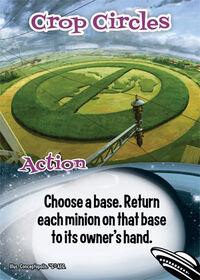
Whether its your own minion or an opponent's minion, it is usually not very significant to return a minion to its owner's hand. There are three reasons why you would want to do it:
- Slow things down. By "unplaying" a minion, you delay the game from progressing by making someone repeat what they've already done. This is most effectively done with Crop Circles as it can return several minions at once.
- Enable the minion's on-play ability to be reused. This can be helpful for particularly strong minion abilities, such as the strongest minion ability of all, the Invader.
- Get rid of things attached to the minion. This is particularly effective against Überserum which protects its owner from being destroyed, but not from being returned. When a minion is returned, anything attached to it is discarded.
Defense
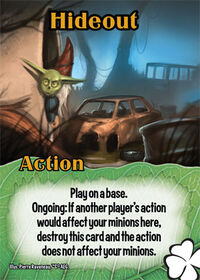
In general, defensive abilities are weaker than offensive abilities. Consider an ability that prevents your minions from being destroyed, but you're playing against factions that have no way of destroying minions. In that case, the defense is pretty worthless. The biggest problem with defensive abilities is that they don't really help you win; they prevent your opponent from preventing you from winning. In the grand scheme of things, the benefits of defensive abilities are very indirect.
Defense is most effectively used to counter specific cards you know your opponents have in their factions. For example, if you're playing against the Ninjas, you might want to protect any important power 3 minions you have from Tiger Assassin, Seeing Stars, and Ninja Master, but if you're playing against Wizard Zombies, you are effectively indestructible already since those factions have no way of destroying your minions. Knowing your opponents' factions is the key to assessing how valuable defensive abilities are.
It's worth noting that the official rules define the word "affect" very strangely, so for example Shielding cannot stop Tinx from swiping Juiced Up. Also pay careful attention to the exact wording on defensive cards. For example, Wildlife Preserve only defends against other players' actions, not their minion abilities. Another example is that Incorporeal does not defend your minion against your own abilities or against base abilities like Mushroom Kingdom. It's also worth noting that while Tooth and Claw... and Guns seems like a defensive ability, it can also be used as an offensive card as it can be played on an opponent's minion to block a helpful ability from affecting it.
Drawing Cards
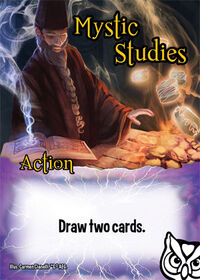
Unless you're the Ghosts, drawing cards is almost always beneficial, especially early in the game. Typically, players will want to be playing with a full hand of 10 cards as this gives you the most flexibility to do various things on your turn.
But drawing cards isn't just important to get your hand up to 10. It's usually even more important to draw cards in order to find the important cards in your deck. Many strategies depend on particular cards (such as Invader or Full Sail), so if the cards you need are randomly located at the bottom of your deck, you'll need to draw cards quickly in order to get to them. For this reason, players should not be afraid to overload their hand beyond the 10-card limit and have to discard at the end of their turn. Don't think of drawing cards as only affecting your hand; it also affects your deck. The faster you get to the end of your deck, the sooner you'll have the cards you need.
Discarding Cards
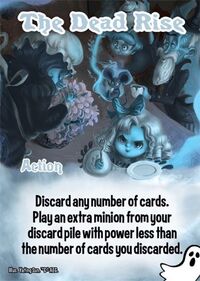
Sometimes abilities require you to discard cards, or sometimes you have over 10 cards in your hand at the end of Phase 4. Either way, you need to decide what to discard.
The best cards to discard are those that are more powerful in the discard pile than in your hand, such as Tenacious Z. The next best are those that still have a special ability that functions from the discard pile, such as Spectre. Also consider other cards that can rescue cards from the discard pile such as Zombie Lord and Mechanic.
If everything in your hand still seems better to keep than to discard, it's a contest for what's the least important to keep. Generally actions are less valuable than minions, and defense (Incorporeal, etc.) is less valuable than offense (Ghostly Arrival, etc.). If your factions have no ability to play multiple actions per turn, consider how valuable each action in your hand will be in isolation. For example, actions that boost minion power until the end of the turn might be less important to your strategy than actions that let you play extra minions.
Forcing Opponents to Discard Random Cards
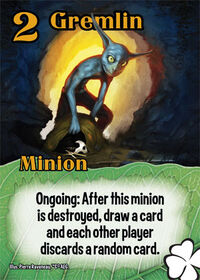
This applies to Take the Shinies, Spreading Horror, Griefer, Magic Acorns, and a few others. Even if your opponents are the Ghosts, Zombies, or Steampunks, forcing opponents to discard at random is almost always beneficial. You want them to discard their powerful cards (except for cards that work well in the discard pile, obviously) like their high-power minions and actions that are key to their strategy. If you know for sure your opponents have these cards (revealed by Neophyte, The Price of Power, Probe, Begin the Summoning, etc.), then you should probably act quickly. But since most players won't have the luxury of certain knowledge, there are tricks to predict when your opponents probably have valuable cards.
As a player draws cards over time, the likelihood that they get their good cards in their hand increases. However, the longer a player holds onto their good cards, the likelihood that they will keep holding onto them decreases. After they've played their good cards, it's too late. There is a window of time when it is best to force them to discard.
Players are most likely to have their good cards while they are building up power slowly on a base preparing for a Big Drop. However, it's risky to try to force them to discard at this time, because you might not disrupt their Big Drop, and then you'll probably miss out on base breaking opportunity yourself. Right after an opponent pulls off a Big Drop, they probably don't have anything good left in their hands; they probably just played it all. However, in a 3+ player game, the other opponents might still have good cards.
All things considered, the best and safest time to force opponents to discard is probably a turn or two into the lull between bases breaking. Your opponents will have had a chance to draw some new cards, and the opportunity cost for you to play the action is pretty low risk.
Shuffling Select Cards Into Your Deck
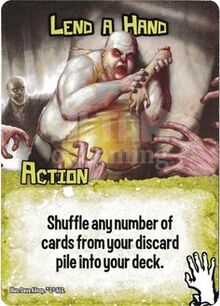
This applies to Microbot Reclaimer, Lend a Hand, It Begins Again, Wormhole, and Direct to DVD Sequel. Whenever you can shuffle cards of your choice into your deck, the size of your deck works against the effectiveness of your choice. The smaller your deck is, the more prevalent the cards will be that you put in it. Imagine the extreme case where your deck is empty and you shuffle two cards from your discard pile into your deck. At the end of the turn, you draw exactly those two cards, effectively turning the "shuffle into your deck" ability into a "place from your discard pile into your hand". If your deck is small, say only 8 cards, the effect is still significant, but you'll have to wait a few turns before you get the cards you wanted.
The Microbot Reclaimers are especially proficient with this strategy. Since there are two of them, they can recycle each other into your deck and theoretically pack the deck with exactly the microbots you want forever.
However, getting a small deck is very difficult and requires either drawing cards quickly or slowing the game down tremendously. If you don't have these abilities, you will probably only get through 75% of your deck by the end of the game. In that case, you'll need to use these abilities earlier than you would like. The smaller your deck, the better, but also the earlier you use the ability, the more time you'll have to find the cards you put there. This balance is tricky, and will ultimately leave much of your fate to chance.
Doing Nothing
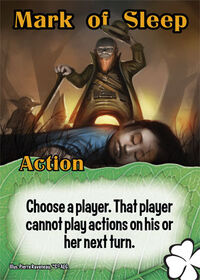
Sometimes it is advantageous to simply do nothing on your turn. Maybe you've got some minions to play, but you don't have a plan. If you find yourself wanting to play a minion just because you "gotta do something", you might want to reconsider.
A game of Smash Up undergoes periods of high and low intensity. When a base is close to its breakpoint, it is important to do something about it, but there are many times in a game where there are no cards in play at all, such as the very beginning of the game. During these lulls, it can be harmless to simply do nothing and collect your two cards at the end of your turn. But is it beneficial to do so?
Actions that destroy minions are ubiquitous across the many factions of the game. If your opponent has such an action but you don't have any minions out, they'll probably just hold onto the action. If you play a vulnerable minion because you have nothing better to do, your opponent might simply destroy it with their action, because they have nothing better to do. It might be best to save your minion for a better play later. Consider also that there are abilities that directly benefit from your minions being present, such as Nightstalker.
Even if you are about to draw too many cards and will need to discard, don't dismiss the possibility that you might still want to do nothing. However, if the card you're probably going to discard could instead be used for some small benefit, say Wildlife Preserve, you might consider just playing instead of discarding it.
Although a minority, there are several factions that can destroy actions. If you're considering playing an action on a minion or base because you have nothing better to do, it might be beneficial to go ahead and play them in an attempt to bait your opponents into using up their action-destroying cards.
There are some rare cases where playing actions might actually help your opponents more than it helps you. It may allow the Geeks to play Wil Wheaton or it might give the Shapeshifters a template for Cellular Bonding. However, it's still usually harmless to play unimportant actions.
Number of Players
with 2 players defensive and killing minions is much more viable. It's very important to take a lead and play offensivelly all game long.
with 3 players try to not spend all resources / best plays / combos too early, since the two other players will join up against you.
with 4 players it's too dangerous to play conservatively. As a rule of thumb you never want to do nothing and should aim to secure at least second place in all bases. Landlslide is indeed inevitable here, while Bait and Switch can either work or fail. Only a big drop can ensure a first place.
Epic Turn
An epic turn is defined as a single turn in which you can win the game no matter what the VP score is at the start of the turn, such as earning 18 VPs while your opponents only earn 2 each, or better yet, earning an arbitrary number of VPs. There are very few epic turns known to be possible, and even fewer that are worth trying in a serious game. While epic turns sound like an awesome idea, they usually depend too heavily on either luck or your opponents being incompetent (or just cooperating with you).
Aliens and Minions of Cthulhu
First discussed by J on Board Game Geek[1], this strategy earns arbitrarily many VPs with The Seal is Broken. This strategy is hopelessly dependent on the luck of the draw and should not be seriously attempted.
Step 1: The Homeworld + Altar to Cthulhu + Collector = unlimited actions
This part is fairly simple to do and understand. Play Altar to Cthulhu on The Homeworld. Now play a Collector there, which lets you play an extra action, and extra minion of power 2 or less, and return a minion of power 3 or less there to your hand. Return the Collector itself to your hand, and repeat. Each repetition gives you an extra action to play this turn. We'll need a lot of them.
Step 2: Draw your whole deck into your hand
This part is wildly dependent on luck of the draw (or rather luck of the shuffle). The idea is to gain so much Madness that you can play it to draw your entire deck into your hand. Remember that we can play arbitrarily many actions, thanks to Step 1.
There are 5 cards that let you draw Madness: 2x Corruption, 2x Whispers in Darkness, 1x The Seal is Broken. Each of these cards do other things as well, but all that matters is gaining Madness. We'll refer to these 5 cards with the letter W (for Whispers in Darkness). Other important cards are the Servitor of Cthulhu, which we'll call S, and It Begins Again, which we'll call I. Altar to Cthulhu is A, and a single Collector is C. All other cards are unimportant and will never be played. We'll refer to these other cards as X.
It's worth noting that we can play Servitor of Cthulhu for free on The Homeworld.
For the sake of argument, let's assume perfect luck, which effectively means instead of shuffling our deck, we can arrange it however we want. Let's start with our deck like this:
deck: WWISS SSXXXXXXXX XXXXXXXXXX XXXXXXXXXX hand: ACWWW discard:
Now we do Step 1 and play our three W's to get three M's.
deck: WWISS SSXXXXXXXX XXXXXXXXXX XXXXXXXXXX hand: CMMM discard: WWW
Play all the Madness to draw cards.
deck: SXXXXXXXX XXXXXXXXXX XXXXXXXXXX hand: C WW IS SS discard: WWW M M M
Then play the the W's.
deck: SXXXXXXXX XXXXXXXXXX XXXXXXXXXX hand: CISSS MM discard: WWWMMM WW
And play all but one Madness to draw cards.
deck: XXXXXXX XXXXXXXXXX XXXXXXXXXX hand: CISSSM SX discard: WWWMMMWW M
Now is the turn around. Play It Begins Again to put all the W's and M's back into your deck, and let's assume they end up right on top where we want them.
deck: MMMM WWWWW XXXXXXX XXXXXXXXXX XXXXXXXXXX hand: CSSSS M X discard: I
Then play Servitor of Cthulhu on The Homeworld and use his Talent to put It Begins Again back on the deck.
deck: IMMMM WWWWW XXXXXXX XXXXXXXXXX XXXXXXXXXX hand: CSSS M X discard: S
This completes the turn around. Now repeated play M's and W's and more M's to get the X's into your hand. Always preserve one Madness for the turn around, and each turnaround uses up one S. Optimally, it only takes three S's to draw your entire deck.
Once this has been done, your setup will looks something like this
deck: hand: CIS WWWWW MM XXXXXXXX XXXXXXXXXX XXXXXXXXXX discard: SSS MMMMMMMMMM MMMMMMMMMM
Now we need to clean out the discard pile by repeatedly playing Madness only.
deck: MMMMMMMMMM MMMMMMMMMM hand: CISSSS WWWWW XXXXXXXX XXXXXXXXXX XXXXXXXXXX discard: MM
deck: hand: MMM MMMMMMMMMM CISSSS WWWWW XXXXXXXX XXXXXXXXXX XXXXXXXXXX discard: MMMMMMMMM
deck: MMMMMMMMM hand: MMM MMMMMMMMMM CISSSS WWWWW XXXXXXXX XXXXXXXXXX XXXXXXXXXX discard:
deck: hand: MMMMMMMM MMMMMMMMMM CISSSS WWWWW XXXXXXXX XXXXXXXXXX XXXXXXXXXX discard: MMMM
deck: MMMM hand: MMMMMMMM MMMMMMMMMM CISSSS WWWWW XXXXXXXX XXXXXXXXXX XXXXXXXXXX discard:
Each time you play madness you draw two for the price of one. At that rate, you'll eventually end up with an empty deck and just one Madness in the discard pile
deck: hand: MM MMMMMMMMM MMMMMMMMMM CISSSS WWWWW XXXXXXXX XXXXXXXXXX XXXXXXXXXX discard: M
Now simply return all the madness but one in your hand.
deck: hand: M CISSSS WWWWW XXXXXXXX XXXXXXXXXX XXXXXXXXXX discard: M
Step 3: The Seal is Broken
At this point you should have every card from your factions in your hand except for Altar to Cthulhu which is still played on The Homeworld. You should also have a single Madness card in your hand and a single Madness card in your discard pile. Your deck should be empty.
Now play The Seal is Broken to gain a VP and a Madness. Return a Madness, and play the other Madness to draw two cards. The two cards will be the other Madness from your discard pile and The Seal is Broken. Repeat to gain an arbitrary amount of VPs.
Benevolent Leprechaun on Cave of Shinies
This strategy gains an arbitrary number of VPs, but it requires your opponents to cooperate (or make an Epic Mistake).
You need to be Robots paired with either Steampunks or Mad Scientists, and an opponent needs to have a Leprechaun on Cave of Shinies. Since no sensible Tricksters player would put their Leprechaun on Cave of Shinies, and the Robots, Steampunks, and Mad Scientists have no way of moving opponents minions, this strategy will probably never work.
Play either Escape Hatch or Grave Situation (which do the same thing) on Cave of Shinies where there is an enemy Leprechaun. Now play a Zapbot there, which immediately dies, gives you a VP, goes back into your hand, and lets you play an extra minion of power 2 or less. Repeat to gain an arbitrary number of VPs.
Another good strategy is the use of the powderkeg card (Pirates) on the cave of shinies. Use the card to suicide a large amount of your minions at once, but be warned it can help others as well. This pairs best with robots or a faction that is low power, so you do not have to give others VPs as well.
Epic First Mates
This strategy gains a luck-based amount of VPs by breaking several bases with just four First Mates. Unlike other epic turns, this one is both feasible to pull off, and still rewarding even if you don't win right away.
This is best done by pairing the Pirates with Cyborg Apes. You'll need your First Mates to be strong enough that they have as much power as possible among them, probably at least 20 power. Neither faction can play multiple unqualified actions per turn, so you can only manage to play a single Swashbuckling in addition to any other actions the first mates have attached to them from previous turns. Swashbuckling gets you to 12 power, so the Cyborg Apes will need to contribute at least 8 power. Both Cyberevolutions and Juiced Up make for +10 power, so that's a good start.
Now that you've got a 20-power posse, break a base and head for the next base with a low enough breakpoint. Depending on your luck and how high your power is, you should be able to break several bases this way. The median breakpoint for a base is 20.
The weakness of this strategy is that it will be fairly obvious that you're setting up for it, and your First Mates will probably be destroyed early.
Another combination is pairing with Mad Scientists. Überserum played on a First Mate will make him a growing threat along with being unable to be destroyed. This combination is a slow grow, but once this minion reaches appropriate power it will be dangerous as a multi base breaker. Use of Jolts, Lab Assistant, Angry Mob and Herr Doktor as means to continue building the counters. This strategy can be countered with Aliens, and Time Travelers cards to return minions to your hand and worst still Make Contact which will turn the tide against you.
